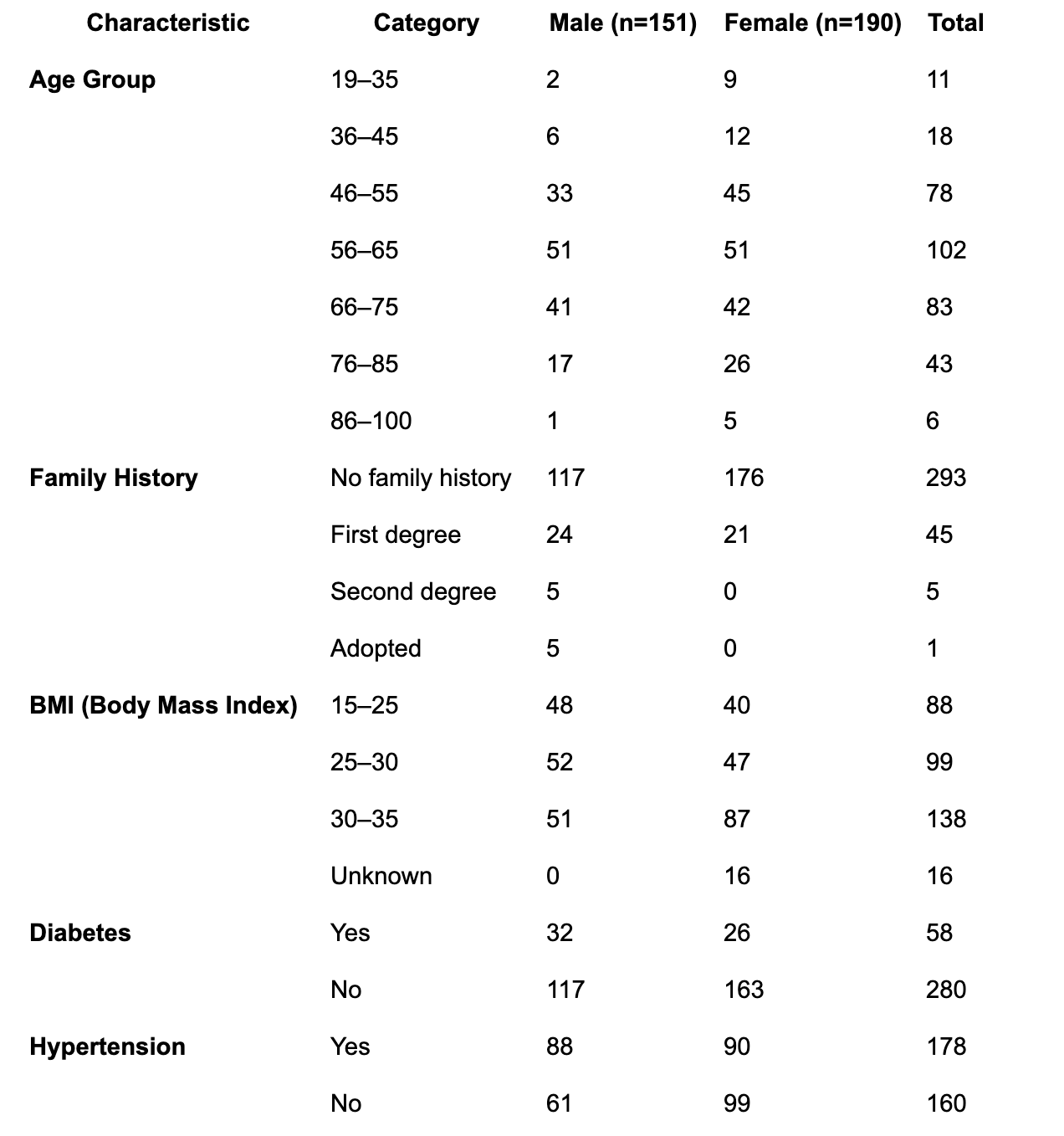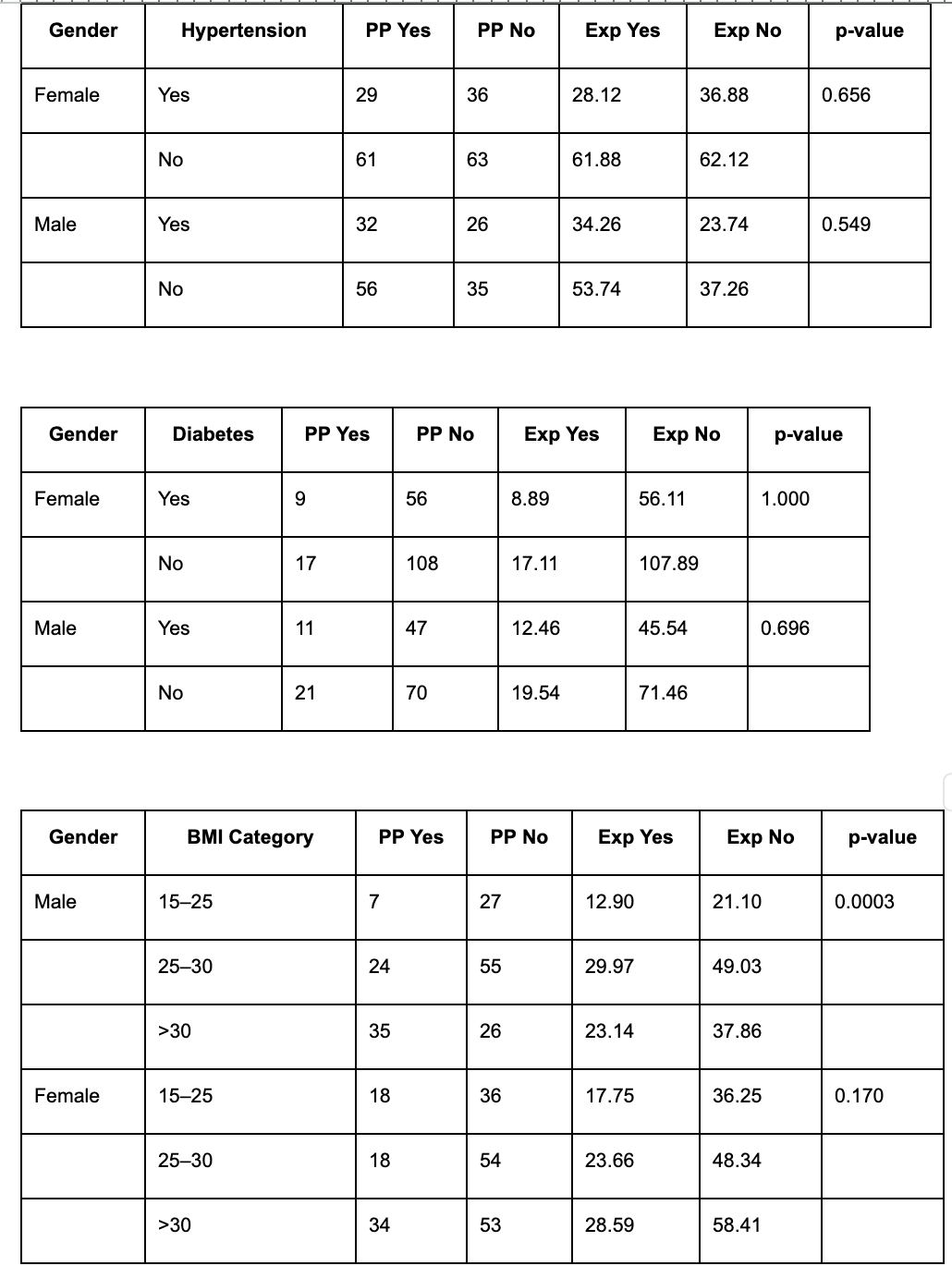Sunday Poster Session
Category: Diet, Nutrition, and Obesity
P0567 - Obesity and Precancerous Colonic Polyps: A Gender-Stratified Retrospective Analysis From a Community Hospital
Sunday, October 26, 2025
3:30 PM - 7:00 PM PDT
Location: Exhibit Hall

Abdullah Hafeez, MD (he/him/his)
Landmark Medical Center
Woonsocket, RI
Presenting Author(s)
Abdullah Hafeez, MD, Omar Alkasabrah, MD, Siddharth Agrawal, MD, Dhruvi Sanikommu, MD, Tanuj Sharma, MD
Landmark Medical Center, Woonsocket, RI
Introduction: Colorectal diseases, including colorectal cancer (CRC), remain major contributors to global morbidity and mortality. Most CRCs arise through the adenoma to carcinoma sequence, and early detection of precancerous polyps (PPs) via colonoscopy significantly reduces progression to malignancy. While current screening guidelines focus on age and family history, emerging evidence suggests that metabolic comorbidities, particularly obesity, may influence PP development. This study examined associations between body mass index (BMI), hypertension (HTN), diabetes mellitus (DM), and PPs, stratified by gender, in a community-based population.
Methods: This retrospective cohort study included 341 adults (151 males and 190 females) who underwent colonoscopy at Landmark Medical Center from 2023 to 2025. Demographics, BMI, family history of CRC, and polyp presence were collected from electronic medical records. BMI was classified as normal (15–24.9), overweight (25–29.9), or obese (≥30). Chi-square analysis assessed associations between comorbidities and PPs, stratified by gender. Statistical significance was set at p < 0.05.
Results: Patients were predominantly aged 46–75 years (54.5%), and 14.7% had a family history of CRC. Among males, obesity was significantly associated with PPs (χ² = 16.96, p = 0.0003), with 35 observed cases in obese males versus 23.14 expected. No significant associations were found between PP prevalence and HTN or DM in either gender. In females, BMI did not significantly correlate with PP presence (χ² = 3.53, p = 0.17), although a trend toward increased prevalence with rising BMI was noted.
Discussion: This study identified obesity as an independent predictor of precancerous colonic polyps in males, even in the absence of a family history of CRC. These findings suggest a potential gender-specific role of BMI in colorectal neoplasia, possibly mediated by hormonal, behavioral, or microbiome-related mechanisms. In contrast, BMI was not a significant predictor in females, highlighting the need for sex-stratified research. These results support the inclusion of BMI in personalized CRC risk assessments, particularly for male patients, and advocate for further investigation into sex-specific screening thresholds.

Figure: Baseline Demographic and Clinical Characteristics of Patients Undergoing Colonoscopy, Stratified by Gender

Figure: Associations Between Comorbidities (Hypertension, Diabetes Mellitus, and Body Mass Index) and Presence of Precancerous Polyps (PP), Stratified by Gender (Observed vs. expected frequencies and statistical significance).
Disclosures:
Abdullah Hafeez indicated no relevant financial relationships.
Omar Alkasabrah indicated no relevant financial relationships.
Siddharth Agrawal indicated no relevant financial relationships.
Dhruvi Sanikommu indicated no relevant financial relationships.
Tanuj Sharma indicated no relevant financial relationships.
Abdullah Hafeez, MD, Omar Alkasabrah, MD, Siddharth Agrawal, MD, Dhruvi Sanikommu, MD, Tanuj Sharma, MD. P0567 - Obesity and Precancerous Colonic Polyps: A Gender-Stratified Retrospective Analysis From a Community Hospital, ACG 2025 Annual Scientific Meeting Abstracts. Phoenix, AZ: American College of Gastroenterology.
Landmark Medical Center, Woonsocket, RI
Introduction: Colorectal diseases, including colorectal cancer (CRC), remain major contributors to global morbidity and mortality. Most CRCs arise through the adenoma to carcinoma sequence, and early detection of precancerous polyps (PPs) via colonoscopy significantly reduces progression to malignancy. While current screening guidelines focus on age and family history, emerging evidence suggests that metabolic comorbidities, particularly obesity, may influence PP development. This study examined associations between body mass index (BMI), hypertension (HTN), diabetes mellitus (DM), and PPs, stratified by gender, in a community-based population.
Methods: This retrospective cohort study included 341 adults (151 males and 190 females) who underwent colonoscopy at Landmark Medical Center from 2023 to 2025. Demographics, BMI, family history of CRC, and polyp presence were collected from electronic medical records. BMI was classified as normal (15–24.9), overweight (25–29.9), or obese (≥30). Chi-square analysis assessed associations between comorbidities and PPs, stratified by gender. Statistical significance was set at p < 0.05.
Results: Patients were predominantly aged 46–75 years (54.5%), and 14.7% had a family history of CRC. Among males, obesity was significantly associated with PPs (χ² = 16.96, p = 0.0003), with 35 observed cases in obese males versus 23.14 expected. No significant associations were found between PP prevalence and HTN or DM in either gender. In females, BMI did not significantly correlate with PP presence (χ² = 3.53, p = 0.17), although a trend toward increased prevalence with rising BMI was noted.
Discussion: This study identified obesity as an independent predictor of precancerous colonic polyps in males, even in the absence of a family history of CRC. These findings suggest a potential gender-specific role of BMI in colorectal neoplasia, possibly mediated by hormonal, behavioral, or microbiome-related mechanisms. In contrast, BMI was not a significant predictor in females, highlighting the need for sex-stratified research. These results support the inclusion of BMI in personalized CRC risk assessments, particularly for male patients, and advocate for further investigation into sex-specific screening thresholds.

Figure: Baseline Demographic and Clinical Characteristics of Patients Undergoing Colonoscopy, Stratified by Gender

Figure: Associations Between Comorbidities (Hypertension, Diabetes Mellitus, and Body Mass Index) and Presence of Precancerous Polyps (PP), Stratified by Gender (Observed vs. expected frequencies and statistical significance).
Disclosures:
Abdullah Hafeez indicated no relevant financial relationships.
Omar Alkasabrah indicated no relevant financial relationships.
Siddharth Agrawal indicated no relevant financial relationships.
Dhruvi Sanikommu indicated no relevant financial relationships.
Tanuj Sharma indicated no relevant financial relationships.
Abdullah Hafeez, MD, Omar Alkasabrah, MD, Siddharth Agrawal, MD, Dhruvi Sanikommu, MD, Tanuj Sharma, MD. P0567 - Obesity and Precancerous Colonic Polyps: A Gender-Stratified Retrospective Analysis From a Community Hospital, ACG 2025 Annual Scientific Meeting Abstracts. Phoenix, AZ: American College of Gastroenterology.
